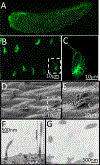Aquatic models of human ciliary diseases
- PMID: 33496382
- PMCID: PMC8593908
- DOI: 10.1002/dvg.23410
Aquatic models of human ciliary diseases
Abstract
Cilia are microtubule-based structures that either transmit information into the cell or move fluid outside of the cell. There are many human diseases that arise from malfunctioning cilia. Although mammalian models provide vital insights into the underlying pathology of these diseases, aquatic organisms such as Xenopus and zebrafish provide valuable tools to help screen and dissect out the underlying causes of these diseases. In this review we focus on recent studies that identify or describe different types of human ciliopathies and outline how aquatic organisms have aided our understanding of these diseases.
Keywords: Xenopus; cilia; ciliopathy; cystic kidney; kidney; nasal; node; zebrafish.
© 2021 Wiley Periodicals LLC.
Figures





References
-
- Ajima Rieko, and Hamada Hiroshi. 2011. “Wnt Signalling Escapes to Cilia.” Nature Cell Biology. - PubMed
-
- Austin-Tse Christina, Halbritter Jan, Zariwala Maimoona A., Gilberti Renée M., Gee Heon Yung, Hellman Nathan, Pathak Narendra, Liu Yan, Panizzi Jennifer R., Patel-King Ramila S., Tritschler Douglas, Bower Raqual, O’Toole Eileen, Porath Jonathan D., Hurd Toby W., Chaki Moumita, Diaz Katrina A., Kohl Stefan, Lovric Svjetlana, Daw Yang Hwang Daniela A. Braun, Schueler Markus, Airik Rannar, Otto Edgar A., Leigh Margaret W., Noone Peadar G., Carson Johnny L., Davis Stephanie D., Pittman Jessica E., Ferkol Thomas W., Atkinson Jeffry J., Olivier Kenneth N., Sagel Scott D., Dell Sharon D., Rosenfeld Margaret, Milla Carlos E., Loges Niki T., Omran Heymut, Porter Mary E., King Stephen M., Knowles Michael R., Drummond Iain A., and Hildebrandt Friedhelm. 2013. “Zebrafish Ciliopathy Screen plus Human Mutational Analysis Identifies C21orf59 and CCDC65 Defects as Causing Primary Ciliary Dyskinesia.” American Journal of Human Genetics. - PMC - PubMed
-
- Baier Herwig, Klostermann Stefan, Trowe Torsten, Karlstrom Rolf O., Nüsslein-Volhard Christiane, and Bonhoeffer Friedrich. 1996. “Genetic Dissection of the Retinotectal Projection.” Development. - PubMed
Publication types
MeSH terms
Grants and funding
LinkOut - more resources
Full Text Sources
Other Literature Sources

